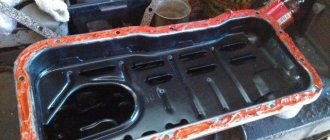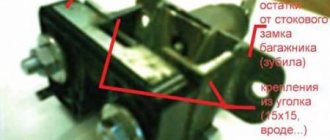05/18/2020 774 Heating
Author: Victor
Motorists usually face the problem of ineffective heating of the vehicle interior in winter. The stove does not work efficiently in all cars, so many car enthusiasts are thinking about installing an autonomous heater (AH). What an autonomous heater is, what types of devices there are and how to install such a device yourself, we will tell you in this article.
[Hide]
Why is additional heating needed?
When storing a car in open parking lots, the metal body of the car quickly cools down. The inside of the glass is covered with a thin layer of condensation, which later turns into an ice crust. Within a few hours of parking, almost all parts, including all rows of seats, reach ambient temperature.
Heating adjustment from the passenger compartment
In the morning, the driver tries to quickly bring a cold car to normal temperature, but for such a stressful state of the car, one stove will not be enough . Even if you start driving in a poorly warmed car, you can wait more than one hour for it to reach normal temperature conditions.
If, from the very beginning, all the heat is taken from a cold car to heat the interior, then there will not be enough heat for the engine to return to normal temperature conditions, which means that the power plant will have less and less heat for the interior and will not be able to do without an additional heater.
A frozen driver is ineffective at driving. He is stressed and may lose attention and control of the road. This can lead to emergency situations.
Types of additional heaters
The driver can choose the most suitable option from several types of heaters. They differ in installation method, energy consumption, cost and appearance.
Electrical devices
The simplest type of additional heating. It is plugged into the car's cigarette lighter and is most often mounted on the front panel. For its low cost, young motorists love it. More experienced drivers try to use it less often, and only as a hair dryer to warm up the glass.
Positive properties:
- low cost of the device;
- simple installation that does not require the involvement of third-party specialists from the station;
- power comes from a battery or generator, without wasting fuel;
- ready for use immediately after switching on;
- has neutral colors and discreet shapes, which makes it easy to fit into salons of any color;
- Available at almost any auto store.
Negative properties:
- there are a large number of low-quality cheap fakes that can be dangerous during operation;
- in high modes it consumes a lot of electricity, and with prolonged use of the battery it can quickly discharge it;
- negatively affects electrical wiring, so it is recommended to connect it directly with more powerful wires.
Autonomous heaters
Most often, such an additional stove in the cabin is installed on minivans, minibuses, residential vans or trucks. Its power comes from fuel. The stove is equipped with an independent combustion chamber and exhaust pipe. Because of this, it is mounted outside the passenger compartment in the engine compartment. The operation of the device does not depend on the motor and is therefore called autonomous.
Positive properties:
- the performance of the unit does not depend on the degree of heating of the power plant;
- there is the possibility of adjustment from the cabin;
- does not change the interior of the car;
- ready to work immediately after startup;
- high recoil power.
Negative properties:
- more complex installation is required than when installing an electric heater;
- additional fuel consumption occurs when the heater is operating;
- the cost is higher than that of an electric heater;
- additional noise appears from the operation of the device.
What kind of heater should you make for your home?
Almost all types of heaters can be made at home. The exception is the inverter, because its design is very complex. Most modern devices create heat with virtually 100% efficiency. All of them have an electric heating element, the main part of which is nichrome wire.
The simplest homemade heater for a garage and a house made from this wire has the following structure:
- Horizontal ceramic pipe with a diameter of 12 cm.
- Four supports.
- Wire wound around a pipe.
- A wire with a plug is connected to the wire.
Such a heater is unsafe, because in addition to the fact that the wire can heat up to 1,000 °C, it also remains open. Contact with it threatens not only burns, but also electric shock. Also, such a device can burn down part of the house.
Unlike most heating devices, it does not heat the air around it, but gives off heat to surrounding objects. It only heats what is needed.
Additional heating factors
Before installing a second heater in the cabin, it is necessary to insulate the car. Since with any number of heaters, they will all be useless if the bulk of the warm air simply escapes through cracks or weak spots.
All rubber bands must provide a seal inside the car. If some of them have lost their elasticity, then an urgent replacement is necessary. For high-quality heating in winter, it is necessary to remove the cold air suction. You can simply disconnect the cable from the control levers for the winter. It is better to open the stove tap in winter to the maximum position.
Installation of equipment
Installation of an additional stove in the cabin occurs in several stages:
- Preparing the installation site . Most often, given the rather large dimensions of the device (depending on the power, respectively, the more powerful the larger in size) it fits into some niche. Since passenger vehicles are often provided with free space in the cabin, this place most often turns out to be the space under the seat. This arrangement allows, in addition to saving space in the cabin, to effectively distribute air flow and effectively heat the space; Then you need to lay pipes from the device to the standard ventilation system (connect one to the factory pump and the other from the cylinder head);
- Power supply in budget options is most often provided through a standard system (from the cigarette lighter) . This ensures production savings, since products powered from an inverter or from a fixed network must have a different device with additional elements, and accordingly the cost of the entire device will be higher.
In the video there is an additional heater in the car interior from the cigarette lighter:
Do-it-yourself installation of an autonomous heater in a car
The installation of electric heaters and preheaters is described in detail in the article (Engine preheater), but installing a gas heater yourself is a serious danger. Therefore, we will not describe the connection of these devices, but we will talk about the connection of air and water heaters running on gasoline and diesel fuel.
- Carefully read the installation instructions for the auxiliary heater and make sure that you have all the necessary equipment. If some equipment is not included in the heater kit, purchase it separately.
- Determine the location for installing the heater and how it is attached.
- Consider the routing of the fuel line and electrical wiring. In most cases, auxiliary heaters are connected to the vehicle’s fuel tank, but it is possible to install a separate fuel tank with a capacity of 1–5 liters. For the pipeline, use a copper or steel tube 3–5 mm thick. It is used to make fuel and brake lines for passenger cars, so you can buy the pipe at any auto store. If for some reason it is not possible to install a metal pipe, use a rubber fuel hose with a minimum diameter.
- Having determined the configuration of the fuel line, lay a tube or hose and attach it to the body using plastic or metal clamps and bolts or self-tapping screws. Treat holes for bolts and screws with anti-corrosion solutions.
- Lay out the electrical wiring, be sure to install a fuse and switch.
- Find a location for the control panel and connect it to the wiring.
- Lay a coaxial air duct-chimney. If it is not included in the kit, then lay the air supply hose and the exhaust gas outlet hose. Be sure to attach the hoses to the body and make sure that they do not interfere with walking around the cabin and that no one will accidentally break them or crush them with their feet.
- Install, secure and connect the heater.
- If you are installing a water heater, then connect it to the car's cooling system according to the instructions. After this, start the engine and make sure there are no coolant leaks.
- Check the fuel supply pipe for leaks and repair them if necessary.
- Turn on the heater and measure the current consumption. If it exceeds that specified in the instructions by more than 20%, then find and eliminate the cause of excessive power consumption.
- Wait for the heater to warm the interior or coolant to ensure proper operation.
Manufacturers
The most popular manufacturers among domestic car enthusiasts are:
- Lifey is a Chinese manufacturer of automotive components. It gained popularity due to its favorable price. Small units can be purchased for between 1500-2000 rubles, which is significantly cheaper than their closest competitors. However, the disadvantage of the manufacturer is the unstable quality inherent in all budget manufacturers, while all installation work can be done with your own hands.
- Webasto - one of the market leaders producing equipment for heating cars. It is distinguished by consistently high quality and the same high cost. Units from this company are characterized by high endurance (on average they can last for 7-8 years);
- KRC is an automotive components company. It has been present on the market not long ago and is fighting against competitors by balancing attractive prices and fairly high quality products. According to the developer, the service life of the product is about 4-5 years.
The UAZ Patriot car has a fairly large and voluminous interior. This is a big plus when you need to transport things or carry passengers. But a large interior, in addition to convenience and comfort, requires considerable heating costs. The UAZ Patriot SUV is equipped from the factory with a standard interior heater, which, according to manufacturers' calculations, should heat the entire area of the car. Indeed, the heater copes with its task of heating the interior, but only if the temperature outside is not lower than -5 degrees. The drop in temperature outside is especially clearly felt by passengers in the rear seats.
Rear interior heater options
The UAZ Patriot car does not provide such a function as heated seats. The interior heater, when operating, provides warm air primarily to the driver and front seat passenger. And if on the road and at sub-zero temperatures the only stove in the cabin fails, what should you do? To solve such problems, the UAZ Patriot SUV has a special device called an additional heater. This material will tell you about it, and we will also consider the process of its installation and use.
Is it that simple?
Given the apparent simplicity of the heating principle, an air-powered auxiliary heater can hardly be considered as an additional interior heater that can be manufactured with your own hands. In conditions of home-made production, it is practically very difficult to fulfill the requirements:
- to the quality of welding of elements, taking into account the specifics of the thermal load and deformation of the mating elements;
- to the reliability of control systems necessary for the operation of an autonomous heater;
- to prevent deviations from the specified combustion mode, the formation of a large amount of carbon monoxide, burning of the chamber walls and, as a consequence, mixing of combustion products and heated air;
- to ensure control of the launch procedure without the risk of fire.
Another heating option
The classic version of an autonomous heater is a scheme where two circuits are simultaneously assembled in the heating device - an engine antifreeze heating circuit and a heat exchanger for the coolant sent to the cabin heating system.
There are options for an autonomous heating system with minor modifications that have a connected thermally insulated container or hot water tank in the interior heating system. Such a boiler plays the role of both a heat accumulator and a source of hot water. An additional pump pumps and heats the container operating in boiler mode. This type of autonomous heater is most often used for mobile living quarters - mobile homes.
Third option
An electric auxiliary heater, colloquially referred to as a “hairdryer,” serves to quickly warm up the interior at low air temperatures. If your car has a battery with a capacity of at least 75 Ah, use an electric car interior heater, which is structurally a 12-volt analogue of a hair dryer, with the difference that instead of a 220 V home power supply, the voltage of the 12 V battery and generator is used car. You shouldn’t expect African heat in the cabin, but while the car’s heater is warming up to the desired 70-80 o C, such a car interior heater, powered by a cigarette lighter, is indispensable if you urgently need to warm up a lock or remove frost from frozen glass.
- low thermal power and heating speed;
- the need to have a “healthy” and fully charged battery and a working generator.
- the heating element of the “hair dryer” heats up to a high temperature and partially burns the oxygen in the air in the cabin.
- Handling the heater requires care to prevent possible contact of flammable substances with the heating element.
The easiest way to make an autonomous electric car interior heater is to make it yourself using an electric fan powered by a cigarette lighter.
The most common and affordable heater design is a circuit consisting of a 12-volt fan-cooler, used in power supplies and computer cooling systems and a heating panel. The latter is made in the form of a frame or tube made of non-flammable and dielectric material. Elements of covers and housings of powerful electric starters made of textolite or fiberglass are suitable.
As an option, a nichrome spiral stretched on special ceramic mounting chips can be used as a heating element for an autonomous heater. In this case, the panel can be made from any heat-resistant material.
Our additional interior heater operates from a cigarette lighter and a voltage of 12 V, so we use low-resistance nichrome wire in the design:
- Using a tester, measure the resistance of 1 m of wire;
- to obtain a maximum current of 5 A, cut a length of nichrome with a resistance of 2 Ohms and make a spiral by winding the wire around a rod or pencil;
- slightly stretch the resulting spiral so that the distance between the turns of the spiral is at least 2-3 times the thickness of the wire;
- Based on the obtained length of the spiral, we will select the dimensions of the heating panel such that there are at least 4-5 rows of the heating element in the cross-section of the frame.
- Let's fix the spiral on the mounting frame, install the fan and connect a two-core cord with a wire cross-section of at least 1.5 mm 2 to the output contacts.
After assembling the design of the autonomous electric heater, we test it by connecting it to the battery terminals for a short time. If the installation is performed correctly, the heater spiral should not heat up to the “red” state; the direction of movement of the air supplied by the fan must correspond to the design one. Otherwise, it is necessary to change the connection polarity and take it into account when connecting the power plug to the cigarette lighter.
Video on how to make a cabin heater yourself:
Features of the additional heater
Any stove can serve as a second heating, but it is advisable to use a more powerful one, so you can take the product, for example, from a Gazelle car. You can install additional heating on a UAZ Patriot SUV either independently, which will require some knowledge, or with the help of a repair shop.
This is what the factory heater looks like
The second heating makes it possible to provide not only a positive temperature in the interior of the UAZ Patriot SUV, but also prevents passengers in the back seat from freezing. Such an auxiliary stove is installed under the following factors:
- if the UAZ Patriot car is used mainly in regions where winters are particularly harsh and the air temperature reaches -20 degrees or lower;
- if you often have to use an SUV;
- in the case of transporting children, for example, daily to school, kindergarten, etc.
The driver can also install a second interior heater if he feels that the standard stove cannot cope with its functions even with slight drops in temperature. That, however, in this case, it is necessary to check the serviceability of the standard heater, but that’s another story.
Operation and connection
If you decide to install additional heating in the UAZ interior, then you should know that the stoves should be connected in parallel. Parallel connection of the main and auxiliary stoves has the following advantages:
Pulling hoses around the cabin
- No additional load is created on the vehicle's energy system.
- It is possible to control devices independently of each other when installing the switch on additional equipment.
- Two functioning stoves will allow you to heat the interior in a matter of minutes.
- There is no need to worry about passengers riding in the back seat. After all, now heat will flow to them from below.
Using another heater has many positive aspects, and most importantly, it provides comfort in the cabin during the cold season.
When installing heaters sequentially, we end up with one drawback - the inability to turn off one of the stoves. When it gets hot in the cabin, of course, you should turn off the heating, since drying out the air is dangerous for the body.
It is recommended to place an additional stove in the following places: between the front seats; under the front seats. It all depends on the model of heater that you choose for your UAZ Patriot. There are many models of “underseat” heaters for car interiors, but it is important to consider not only the performance of the device, but also the size.
Thus, on a UAZ Patriot SUV you can install a regular radiator, which perhaps someone has lying around in the garage, or a special heater with a built-in fan. Let's look at the installation features of the product.
Installation features
Installation of an additional heater on an SUV is carried out in stages:
- Selecting a location for the unit. It is recommended to place an additional heater under the front seat.
- The engine cooling system is being depressurized. To do this, you need to drain the antifreeze into a special canister.
- The second heater tube crashes into the main heating system. In this case, it should be ensured that these tubes do not come into contact with engine elements that could melt them.
- Two holes are drilled in the engine shield through which hoses are passed into the passenger compartment.
- The heater hoses in the car interior are laid under the floor upholstery.
- The hoses are routed under the front seat. It is advisable to place the device under the passenger seat.
- The laid hoses are secured to the additional heater. In this case, it is imperative to use clamps.
- The interior heater is being installed and hoses are connected to it. After this, it must be secured under the seat.
- It is poured into the expansion tank with pre-drained antifreeze, but this will require a larger volume of coolant.
- The system is purged to remove air from it.
- It is imperative to install and connect the auxiliary heater fan switch to the vehicle network. We recommend installing it on the instrument panel. The switch is installed with the minus terminal removed from the battery.
Antifreeze will circulate in the additional heater, which is pumped by the standard pump. If desired, to ensure greater productivity, you can install an additional pump. At this point, the installation is complete and some disadvantages of such equipment should be considered.
A little about the cons
Of course, the main purpose of the additional heater is to ensure comfort in the cabin by maintaining a temperature of at least 18 degrees in severe frosts. But after installing new equipment, the following negative aspects arise:
- in winter, the engine warms up more slowly;
- the appearance of extra decibels of noise (from an electric fan);
- the appearance of dust that will circulate throughout the cabin due to the operation of fan heaters;
- heating of the floor upholstery where the hoses to the heater pass, which will cause inconvenience in the summer. This problem can be corrected by installing a faucet on the hose leading to the Patriot's heater.
Another disadvantage is the cost of the equipment. A special additional stove designed for installation under the seat will cost a decent amount, so not everyone is ready to go to such expense. Many craftsmen begin to invent heaters on their own, but this is not always safe.
Thus, to summarize, it should be noted that before deciding to install an additional stove, you need to weigh all the pros and cons. But the most important thing to consider is your region of residence. Residents of the northern and middle regions need the installation of such equipment.
>
Disadvantages of cigarette lighter stoves and features of choice
In addition to the fact that the devices are only called heaters in a big word and in fact they are not capable of performing this function fully, such stoves also have other negative aspects:
- There are often Chinese counterfeits on sale that not only do not heat the interior properly, but lead to the cigarette lighter melting. There is even a risk of fire.
- With prolonged use of the product, the battery charge level decreases. This is especially true for cars with a low-power power unit.
- Some models need to be mounted using self-tapping screws. As a result, you will have to damage the interior.
- Heaters of this type are not suitable for all cars.
- In some cases (if the stove is too weak), the heating is so insignificant that the temperature in the cabin does not rise at all.
Important! Before purchasing a heater, it is important to study the technical specifications of the car. In some models, the use of such devices leads to the fuses of the socket circuit burning out. For example, this often happens in first-generation Logans equipped with ten-amp fuses.
To minimize the negative aspects of such heaters, you should take their choice seriously and pay attention to the following nuances:
- The body of the product must be made of heat-resistant material. If the stove smells like cheap plastic, then it is better to refuse such a purchase.
- The heating element is the most important. It is better to choose models with a ceramic heater, which is fireproof.
- You shouldn't buy more powerful devices. Not only will they not heat up the interior, but they will also negatively affect the electrical network, which will simply fail. Therefore, the best option would be a device with 150-200 W.
- Since the product is capable of heating surfaces only over a short distance, it is better to choose models with a long cord. Then the heater can be directed to the rear windows.
- Don’t be shy about asking the seller for a quality certificate. Since the device may catch fire, it must be accompanied by appropriate documentation.
- It is better to buy a more expensive model equipped with a thermostat and additional protection against overheating.
Healthy! There are models on sale that run on their own battery.
- The wiring connection must be of high quality.
- It is worth giving preference to well-known manufacturers who provide a guarantee for their products.











